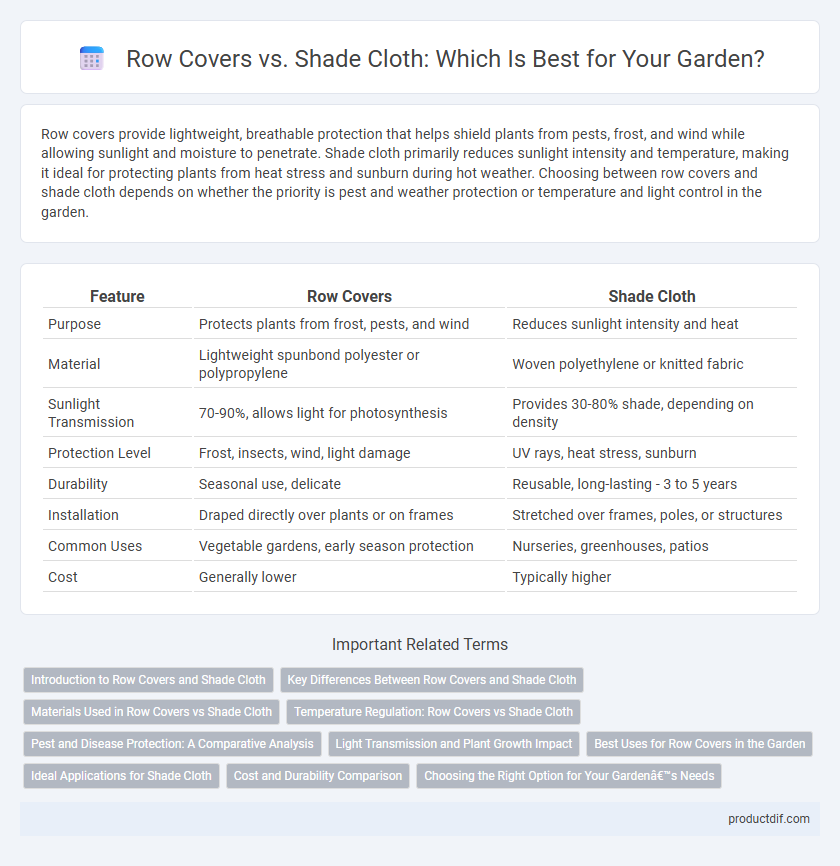Row covers provide lightweight, breathable protection that helps shield plants from pests, frost, and wind while allowing sunlight and moisture to penetrate. Shade cloth primarily reduces sunlight intensity and temperature, making it ideal for protecting plants from heat stress and sunburn during hot weather. Choosing between row covers and shade cloth depends on whether the priority is pest and weather protection or temperature and light control in the garden.
Table of Comparison
| Feature | Row Covers | Shade Cloth |
|---|---|---|
| Purpose | Protects plants from frost, pests, and wind | Reduces sunlight intensity and heat |
| Material | Lightweight spunbond polyester or polypropylene | Woven polyethylene or knitted fabric |
| Sunlight Transmission | 70-90%, allows light for photosynthesis | Provides 30-80% shade, depending on density |
| Protection Level | Frost, insects, wind, light damage | UV rays, heat stress, sunburn |
| Durability | Seasonal use, delicate | Reusable, long-lasting - 3 to 5 years |
| Installation | Draped directly over plants or on frames | Stretched over frames, poles, or structures |
| Common Uses | Vegetable gardens, early season protection | Nurseries, greenhouses, patios |
| Cost | Generally lower | Typically higher |
Introduction to Row Covers and Shade Cloth
Row covers and shade cloth are essential garden supplies designed to protect plants from various environmental factors. Row covers, typically lightweight and made of spun bond fabric, shield plants from frost, pests, and wind while allowing sunlight and moisture to penetrate. Shade cloth, constructed from knitted or woven fabric, reduces sunlight intensity and heat, making it ideal for protecting plants from excessive sun exposure during hot weather.
Key Differences Between Row Covers and Shade Cloth
Row covers provide frost protection and help retain heat, making them ideal for extending the growing season and shielding plants from cold temperatures. Shade cloth primarily reduces sunlight intensity and heat, protecting plants from sunburn and excessive heat stress during hot weather. While row covers are typically made from lightweight, breathable fabric that allows moisture and air to pass, shade cloths are woven with varying densities to block specific percentages of sunlight.
Materials Used in Row Covers vs Shade Cloth
Row covers are typically made from lightweight materials such as spunbonded polypropylene or polyester fabric, designed to provide frost protection and pest barrier while allowing air, light, and moisture to pass through. Shade cloth consists of woven or knitted polyethylene or polypropylene fabric that blocks a specific percentage of sunlight to reduce heat and UV exposure, promoting cooler plant environments. The choice of material directly affects durability, breathability, and the level of protection tailored to different gardening needs.
Temperature Regulation: Row Covers vs Shade Cloth
Row covers provide effective temperature regulation by trapping heat and protecting plants from frost, making them ideal for cooler climates and early spring planting. Shade cloth, on the other hand, reduces sunlight intensity and lowers air temperature, preventing overheating during hot summer months. Choosing between row covers and shade cloth depends on whether the primary need is frost protection or heat reduction in garden environments.
Pest and Disease Protection: A Comparative Analysis
Row covers provide a physical barrier that effectively deters insect pests and reduces the spread of diseases by limiting plant exposure to airborne pathogens, while shade cloth primarily offers protection from excessive sunlight and does not prevent pest infiltration. The dense weave of row covers blocks common pests such as aphids and beetles, thereby minimizing the need for chemical interventions and enhancing organic gardening practices. In contrast, shade cloth's porous design allows airflow and insects to penetrate, making it less effective for integrated pest management but beneficial for temperature regulation.
Light Transmission and Plant Growth Impact
Row covers typically offer 50-70% light transmission, creating a warm microclimate that accelerates seedling development and protects plants from frost and pests. Shade cloths allow variable light filtration, ranging from 30-90%, which helps reduce heat stress and prevents sunburn on delicate plants without significantly hindering photosynthesis. Optimizing light transmission with the appropriate material enhances plant growth by balancing protection and natural sunlight exposure in garden environments.
Best Uses for Row Covers in the Garden
Row covers provide effective protection against pests, frost, and harsh weather while allowing sunlight, air, and moisture to reach plants, making them ideal for extending the growing season and protecting seedlings. These lightweight fabrics are best used for vegetables, berries, and young plants that require a temperature-controlled environment to thrive. Unlike shade cloth, row covers enhance microclimates around plants without significantly reducing light intensity, promoting healthier growth and higher yields.
Ideal Applications for Shade Cloth
Shade cloth is ideal for protecting plants from excessive sunlight and heat, making it perfect for nurseries, greenhouses, and outdoor gardens in hot climates. It effectively reduces light intensity by 30-70%, ensuring optimal photosynthesis while preventing leaf scorch and moisture loss. Applications include vegetable gardens, ornamental plants, and seedling protection where moderated light levels and temperature control are essential.
Cost and Durability Comparison
Row covers typically cost between $0.10 to $0.30 per square foot and offer moderate durability, lasting 1-3 seasons depending on material quality. Shade cloth is generally more expensive, ranging from $0.50 to $2.00 per square foot, but provides greater UV resistance and can last 3-7 years under regular use. Investing in shade cloth may yield longer-term savings despite higher upfront costs due to its superior durability and protective benefits.
Choosing the Right Option for Your Garden’s Needs
Row covers provide lightweight protection against frost, pests, and wind, making them ideal for extending the growing season and safeguarding young plants. Shade cloth reduces heat and sun exposure, preventing crop damage during intense summer conditions and promoting healthier growth for heat-sensitive plants. Selecting the right option depends on your garden's specific climate challenges, crop types, and seasonal requirements to optimize plant health and yield.
Row covers vs Shade cloth Infographic

 productdif.com
productdif.com